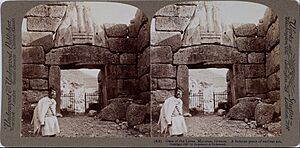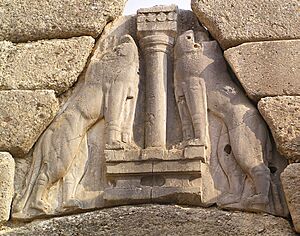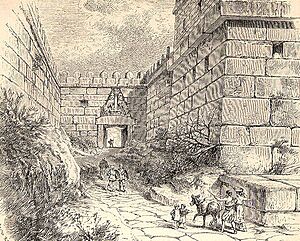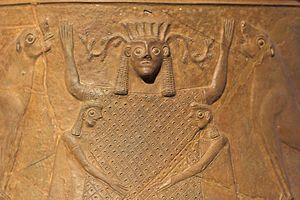Lion Gate facts for kids
Quick facts for kids Lion Gate |
|
|---|---|
| Native name Greek: Πύλη των Λεόντων |
|
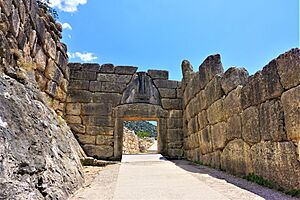 |
|
| Location | Mycenae |
| Area | Argolis, Greece |
| Built | 1250 BC |
| Built for | Main entrance of the Mycenae citadel |
| Architectural style(s) | Conglomerate Ashlar |
The Lion Gate (Greek: Πύλη των Λεόντων) is the famous main entrance to the ancient city of Mycenae in Southern Greece. This impressive gate was built around 1250 BC, during the Bronze Age. It stands on the northwestern side of the city's highest point, called the acropolis.
The gate gets its modern name from a special stone carving above the entrance. This carving shows two large lions or lionesses standing in a proud, upright pose. It is the only major piece of Mycenaean sculpture that still exists today. It's also the largest surviving ancient sculpture in the Aegean region from that time.
The Lion Gate is unique because its famous carving was never buried. This means people knew about it even before modern archaeologists started digging. Ancient writers, like Pausanias, even described it in their books.
Entering the Ancient City
Most of the huge walls around Mycenae, including the Lion Gate, were built during a big expansion of the city. This happened in the 13th century BC. During this time, the city walls were made bigger to include Grave Circle A. This was an important burial place for royal families from an earlier period.
After this expansion, Mycenae had two main ways to get in: the main Lion Gate and a smaller back gate. The Lion Gate was the most important change to the city's defenses. It was built around 1250 BC on the northwest side.
To reach the gate, you would walk up a path that was partly natural and partly built. On one side of this path was a steep, smooth slope. On the other side, a strong, rectangular tower, called a bastion, was built. This tower was about 14.8 meters (48.6 feet) long and 7.23 meters (23.7 feet) wide. It was made from huge stone blocks.
People call this building style "Cyclopean" because the blocks are so big. It was thought that only mythical giants, called Cyclopes, could have moved such massive stones.
The path narrowed into a small open area, about 15 by 7.23 meters (49.2 by 23.7 feet), right before the gate. This small space probably helped limit how many attackers could reach the gate at once. The tower on the right side of the gate was very useful for defending against enemies. Attackers usually carried their shields on their left arms, leaving their right sides open to attack from the tower.
How the Gate Was Built
The Lion Gate is a very strong and impressive structure. It is about 3.10 meters (10.2 feet) wide and 2.95 meters (9.7 feet) high at the bottom. It gets a little narrower as it goes up. The opening was closed by a double wooden door that turned on a central pole.
The gate itself is made of two huge stone blocks standing upright. On top of these is a massive stone lintel, which is like a giant crossbeam. This lintel measures about 4.5 by 2.0 by 0.8 meters (14.8 by 6.6 by 2.6 feet).
Above this lintel, the stones are arranged to form a triangle shape. This is called a "relieving triangle." It helps to take some of the heavy weight off the lintel stone below. Inside this triangle is a large limestone slab with the famous carving.
The carving shows two lionesses standing on either side of a central pillar. Their heads are missing, but their necks are still there. It's believed their heads were made from a different material and faced outwards, looking down at people approaching the gate. The pillar in the middle is a type of column often seen in Minoan art. The lionesses rest their front paws on a platform that looks like an altar.
Similar images from ancient times show a goddess with two lions or lionesses. This suggests the carving on the Lion Gate might have had a religious meaning. The tufts on the animals' tails clearly show they are lionesses.
The powerful Lion Gate, with its lioness carving, was a symbol of the Mycenaean kings. It showed their strength to everyone, both their own people and visitors from other lands. Some people also believe the lions might represent the goddess Hera.
This gate is similar to gates found at the Hittite city of Hattusa in Asia Minor. Because the heads of the animals were made separately, some experts think they might have been mythical creatures like sphinxes, which were common in the Middle East.
On top of the central pillar, there are four round shapes. These might represent the ends of wooden beams that supported another sculpture that is now lost. Another idea is that these shapes are just part of the architectural design, showing how the structure above the column would have looked.
The design of the Lion Gate was not completely new. Similar images have been found on ancient seals and gems from the 15th century BC. For example, a large storage jar (called a pithos) from Knossos shows a goddess with two lionesses. Many other Mycenaean artworks show two animals facing each other, separated by something in the middle, like a column or a sacred tree.
The design on the gate might represent the entrance to a palace, with a central column. If so, the symbol of a holy palace entrance would have been placed above the city's main gate. This would have been like a double blessing or protection. The lions acted as powerful guardians for the city's entrance.
Just inside the gate, there was a covered area with a small room. This room was probably used as a guard post. Next to the wall, there was a building that archaeologists believe was a granary. This is because large storage jars, called pithoi, were found there, containing burnt wheat.
Discovering the Gate
The Lion Gate has been visible for hundreds of years. The ancient writer Pausanias wrote about it in the 2nd century AD. In modern times, the gate was first correctly identified in 1700 by Francesco Grimani. He used Pausanias's description to find the ruins of Mycenae.
In 1840, the Greek Archaeological Society started clearing away the dirt and debris that had covered the site. Later, in 1876, Heinrich Schliemann also used Pausanias's writings to guide his excavations. He dug in the area south of the gate, finding many important artifacts.
See also
- Cyclopean masonry
- Grave Circle A, Mycenae
- Mycenaean civilization
- Royal Institute of British Architects, whose emblem is a modified representation of the gate sculpture


